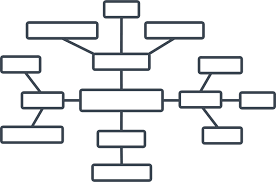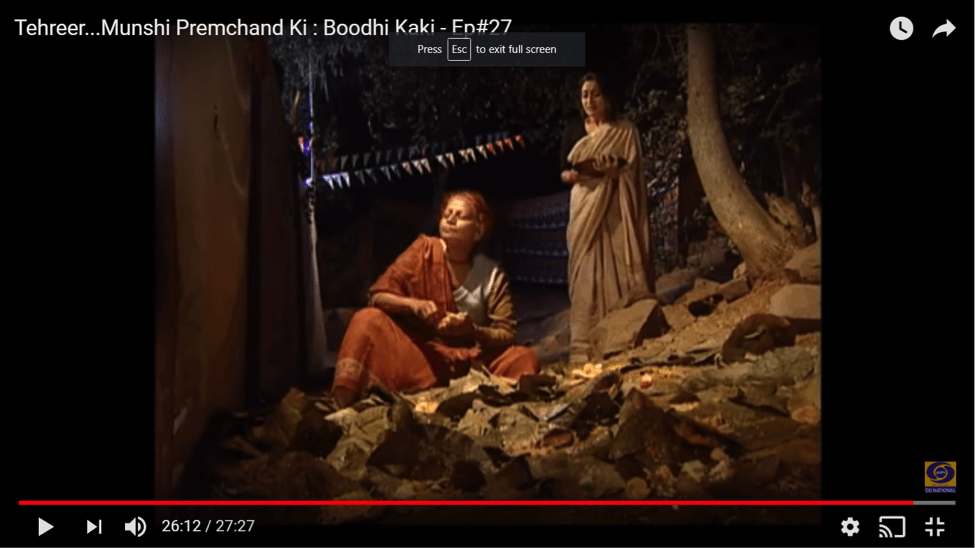Lesson plan by Rajni Bhargava
I. Proficiency level: Intermediate Mid (Time: 2X75 min)
II. Objectives: Students will be able to:
- describe the characters of the story
- ask and answer questions on the plot of the story
- understand aspects of village life
III. Language Targets: Students will use appropriately:
- subjunctive: (a) in simple sentences as polite suggestion, request, wish or instruction: सार्वजनिक यातायात सुलभ हो, or (b) in complex sentences with an introductory clause:आशा है कि…; यह ज़रूरी बात है कि…; …ताकि…
- Verb stem + सकना: जी सके; काम कर सकता है
- ask and answer complex questions
IV. Standards: Communication in all 3 modes and Culture
V. Performance Assessment:
- Interpretive: Students read sections of the story “बूढ़ी काकी” by Premchand.
- Interpersonal: Students do jigsaw to put together the whole story.
- Presentational: Students in groups write to an NGO, newly-established in India, seeking ideas for building homes and helping people of old age.
VI. Materials:
- The whole story is condensed into four screen shots with the original text in segments
- https://www.youtube.com/watch?v=H4D_eIQZGoE&t=47s (27.14 min)
1. Students are given the last screen shot and asked to brainstorm on what they can see in the picture. They brainstorm about who the characters in the picture are and what is on the picture itself, what might have happened in the story, who might be the other characters in the story?
2. Students categorize the information on a concept map.
3. There are lots of non-standard phrases and idioms used in the story. Students are given the vocabulary sheet for support. In pairs they make categories of the glossary.
Vocabulary for बूढ़ी काकी
- इज्जत – मान रखना
- पांय लागन –पांव छूना
- पेट में जलन – भूख लगना
- पानी गटक – पानी पीना
- चटोरापन – खाना बहुत पसंद आना
- जायदाद – ज़मीन और पैसे
- अवध की ज़मींदारी – बहुत सारी ज़मीन
- अक्ल पर पत्थर पड़ गए थे – कुछ समझ नहीं आना
- डकार चुकी – खा चुकी
- पेट है या नरक की आग – भूख मिटती नहीं
- शादी तय हो गई – शादी पक्की हो जाना
- तांक झांक करना – इधर उधर देखना
- बर्दाश्त – सहन
- फबेगा – अच्छा लगेगा
4. Students are divided into four groups (each student in a group is given a number 1, 2, 3 and 4). Each group gets a handout — one screen shot with the one part of the story written below the image. Students read their segment of the story and are expected to frame questions in a manner that would elicit the rest of the story from the other groups. The questions focus on the plot, the characters, the events, the place, etc. which students need to ask in order to figure out the story when placed in a different group.
5. Students are placed in a different group according to the number assigned before. All the students number 1 form a new group and similarly number 2, 3, and 4 form their new groups. Each one has now one part of the story and everyone has questions to ask to figure out the rest of the story. They all put the story together and narrate the story of their own. The story may be slightly different than the original story.
6. Students watch the film based on the story by Premchand in order to find out if they put the story together correctly. https://www.youtube.com/watch?v=BCBOA4mvFbs
- Are the characters different?
- Is the plot different?
- Is the place different?
- If it is same what is the message which the author is trying to say?
7. In groups students outline the main issues reflected in the story and discuss what their roots are. Then they read an essay and create a mind map of the main social problem. 
8. In newly formed pairs students share their mind map and write their ideas for a letter to a selected NGO on how to support the family or the government to provide help to old people and especially widows, keeping in mind the Indian context like living with joint family, parents whose children don’t live in the same place, due to poverty and other factors. They write sentences in which they use at least:
- 5 subjunctive sentences
- 3 verb forms verb stem + sakna
- 10 new words from the glossary.
Teacher draws attention on examples of subjunctive use:
एक ऐसा शहर जो काम करता हो, जहां लोग साइकिल चला पाते हों, सड़कों पर पैदल चलने की जगह हो, पार्क हो, यातायात सुलझा हुआ हो। सड़कें और इमारतें योजनाबद्ध तरीके से बनी हों, शहरी और सार्वजनिक यातायात सुलभ हो। बिजली, पानी, इंटरनेट जैसे आम सुविधाओं की अबाध्य आपूर्ति हो। बाकी, साफ सफाई हो, शौचालय हो तभी हमारा शहर स्मार्ट बन सकता है।
Note: Suggestion for a follow-up reading on smart cities.
